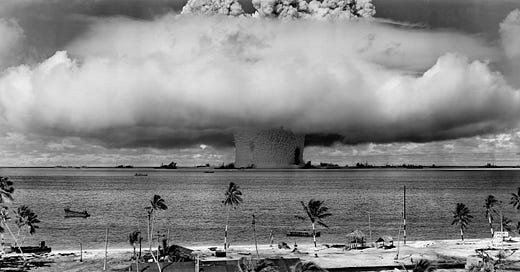Revisiting Dr. Strangelove or: How I Learned to Stop Worrying and Love the Bomb
The return of Cold War emotions and frames make this movie more salient.
The BAKER test of Operation Crossroads, July 25, 1946. Seconds after the water column rose, and formed a condensation cloud, it fell back, unleashing a billowing base surge forming a 500 foot high wall. Courtesy of Shutterstock and the Everett Collection.
There are fifteen nuclear power plants in Ukraine. Putin’s army is seizing nuclear zones and creating intense global fear.
So realistically, this rapid change in the world is hard to articulate as things transform every hour and every day.
As I think about the Cold War, I also want to examine the period’s cultural artifacts.
That is what led me to revisiting the 1964 film, Dr. Strangelove or: How I Learned to Stop Worrying and Love the Bomb. This piece of cinema is widely acclaimed and viewed as one of the best movies ever made. It is a dark comedy that also reflects the deep horrors of the Cold War and global annihilation.
In the film, a mad Air Force general launches nuclear strikes on the U.S.S.R. based on a conspiracy stating that the Soviets were polluting water systems and targeting the precious bodily fluids of Americans. So as bombers diligently follow orders, the President of the United States and the Joint Chiefs try to avert crisis. They end up bringing the Russian Ambassador into the war room to establish communications with the Soviet Union.
But, upon telling the Soviet premier what a rogue general did, a doomsday machine is revealed.
This “doomsday device” is the foundation of Mutually Assured Destruction. This real world foreign policy doctrine was built on the fears of a second nuclear strike in the event of a first nuclear strike by any country.
In the film, the United States launches a nuclear attack and thus the Soviet doomsday machine would trigger and launch missiles at the States. Dr. Strangelove, which was one of the roles played by the acclaimed performer Peter Sellers, explains that this doomsday deterrent only works if the U.S. knows about the device.
Ironically, the machine was going to be announced as a surprise for the Soviet premier. They all knew how much he loved surprises.
There are historical allusions to the Cuban Missile Crisis of 1962. The Soviets sent nuclear missiles to Cuba unbeknownst. After, an American U2 plane uncovered this placement and alarmed the Kennedy administration, and later, the American people.
The missiles were going to be announced in November. But, it was October 16 and the “High Noon of the Cold War” had already started.
Eventually an agreement was made that required the United States to publicly pledge not to invade Cuba, which was under the auspices of the communist Castro regime. Not immediately for public eyes, though, was the agreement to move U.S. missiles out of Turkey in exchange for missiles out of Cuba.
These events influenced Détente and the Anti-Ballistic Missile Treaty of 1972. Theoretically, if it was harder for nations to defend themselves against a nuclear strike then they may not feel confident about sending a first strike knowing a missile will come back in return.
In revisiting this film, I get to reflect on the permeation of nuclear fears as these weapons were even more unknown in the 1960s. On top of that, this was an atmosphere of the utmost paranoia.
The film ends with a montage of nuclear explosions after U.S. leaders reckon with the end of the world. The president’s and premier’s attempts at nuclear deterrence failed as the bomber in focus averts Soviet defense strikes and continues on its bombing mission.
The doomsday machine would certainly be set off.
Major T.J. “King” Kong, played by Slim Pickens, rides the bomb down to earth:
The background music is Vera Lynn’s “We’ll Meet Again.”
Uri Friedman’s article in the Atlantic reminds us of the ambiguities behind nuclear control in each nation:
The U.S. nuclear-launch system has its own ambiguities, but one element is clearer than in Russia’s system: The American president has sole authority to order the use of nuclear weapons, without any need to consult with or obtain the assent of top military or civilian advisers.
It’s a reality rarely dwelled upon, even by those whose job is to dwell on it. In 2017, in the throes of Trump’s vows to rain down “fire and fury” on Kim Jong Un, I tuned in as the Senate Foreign Relations Committee held the first congressional hearing on the subject in 41 years. I was shocked by how many members of Congress’s premier foreign-affairs committee seemed to be just getting up to speed on the commander in chief’s exclusive power in matters of nuclear war.
This concentrated executive authority—which contrasts with more collective decision making in nuclear states such as India and Pakistan, where nuclear-use powers are vested in councils—is in large part a legacy of the Cold War. During that period, the U.S. government chose to categorize nuclear weapons differently than other weapons and put them under the circumscribed civilian control of the country’s democratically elected political leader. The approach was informed by a prolonged nuclear standoff with the Soviet Union that placed a premium on enabling quick decisions, because an American leader might have only minutes to retaliate against a surprise nuclear assault.
Still, in both Russia and the United States, despite what Trump might have led us to believe, the proverbial “nuclear button” is a myth; even with the immense executive authority to launch nuclear weapons in each country, any such presidential order would necessarily need to pass through other individuals with varying degrees of agency.
The specter of nuclear war is frightening and unsettling.
It is at these times when we are reminded why our civic health and our collective reverence to historical events - as well as their cultural artifacts - matter greatly.
***CORRECTION: There are fifteen power plants.






